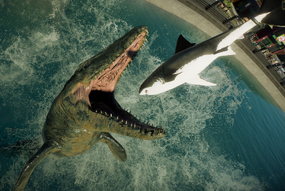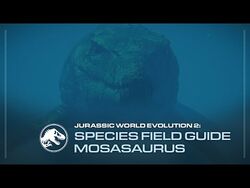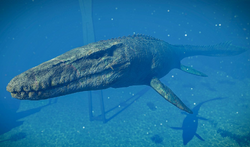| So when people come to the park, they wanna learn something, sure, but they also wanna be entertained, and this marine reptile – the Mosasaurus? Just that, a show-stopper. If the Tyrannosaurus is the ruler of the dinosaurs on land, then the Mosasaurus holds that title below the waves. Make sure this animal is a premium attraction! |
Mosasaurus is a genus of marine reptile in Evolution 2. Originating in Late Cretaceous Europe and North America, the Mosasaurus is an apex predator and the largest marine reptile available.
Mosasaurus is unlocked in the Jurassic World Chaos Theory level and in Challenge Mode, and its fossils can be excavated from the Fox Hills Formation in North America and the Maastricht Formation in Europe. Once one has been researched and successfully released, the species becomes available for use in Sandbox Mode.
History
In 2000, Dr. Henry Wu and InGen were able to extract DNA from a Mosasaurus fossil specimen using a prototype iron analyzer.[1]
The Mosasaurus became Jurassic World's star attraction where it would jump up and catch a shark to feed on in the Mosasaurus Feeding Show. After the park's Pteranodon and Dimorphodon population escaped from the Jurassic World Aviary during the 2015 Isla Nublar Incident, the Mosasaurus managed to devour one of the flying reptiles that was also attacking Zara Young. The Mosasaurus eventually leaped out from its lagoon to kill and feed on the rampaging Indominus rex.[2]
Six months after the fall of Jurassic World, the Mosasaurus remained in its lagoon until mercenaries sent by Eli Mills and Dr. Henry Wu entered the island to retrieve a DNA sample of the Indominus rex. The Mosasaurus managed to devour some of the mercenaries and swam out to the Pacific Ocean after the lagoon's gates were left open.[3]
A year after the events at Lockwood Manor, the Mosasaurus was recorded feeding on a great white shark that had just caught a sea lion.[4]
Four years after the events at the Lockwood Manor, the Mosasaurus was witnessed attacking a crabbing boat off the coast of Alaska and that it had formed a bond with a pod of humpback whales.[5]
Characteristics

A Mosasaurus feeding on a shark.
The largest member and namesake of its family (its name translates to "Lizard of the Meuse River", in reference to the location of its discovery), Mosasaurus is one of the largest marine reptiles in history, growing up to nearly 18 meters in length, and lived in the Late Cretaceous period from 82 to 65 million years ago in the Atlantic Ocean. Mosasaurus' rows of sharp teeth, powerful paddle-like limbs and excellent vision make it an efficient predator, feeding on fish, cephalopods and other marine reptiles. Mosasaurus also has crocodilian-like osteoderms running down its back and tail. Mosasaurus greatly resembles Tylosaurus, but had a more robust physique. The base genome of Mosasaurus are grayish-blue with a creamy underbelly.
Gameplay
In Evolution 2, Mosasaurus has a base appeal of 2,500, the highest of any species. As such, they are a very popular species among all guest types and can provide an immediate boost to park rating and revenue. They are also the most expensive species in the game as it costs $2 Million to extract fossils from the site.
Behaviour
Mosasaurus are a solitary species which do not tolerate any other member of their kind within their Lagoon, or the closely related Tylosaurus, which can result in potentially deadly fights. They tolerate smaller marine species such as Ichthyosaurus and Plesiosaurus, preying upon anything they can sink their jaws into. A unique attribute of the Mosasaurus is its ability to feed from suspended Shark Feeders, allowing the species to lunge out of the water and devour a shark. This makes the Mosasaurus the first marine reptile to eat from Shark Feeders, the second being the considerably smaller Kronosaurus.
Paleontology
Mosasaurus was first discovered as far back as 1764, when skull fragments were excavated from Mount Saint Peter, near the Meuse River in the Netherlands. The findings were initially classified as a type of fish, while a second, similar skull unearthed in 1780 led experts to believe it was a crocodile. It wasn’t until 1822 that it was officially classified as a new genus named Mosasaur by English paleontologist William Daniel Conybeare.
Paleoecology
Although the first Mosasaurus remains were found in Europe, further fossils have been found across the world, from North America to parts of Africa and even Antarctica. As the apex predator of its habitat in the Late Cretaceous period, around 80-65 million years ago, it would not have been attacked by other reptiles – however researchers believe that that it may have fought within its own genus.
Several features of Mosasaurus fossils suggest that this species relied on delivering critical injuries to slow prey with crushing force. Firstly, the reptile's bulky build shows that it was not built for speed or to pursue prey over long distances. It also lacked binocular vision, an advantage most pursuit predators possess to judge distance. Furthermore, Mosasaurus' relatively underdeveloped olfactory bulb - the neural structure responsible for processing scent - implies that it would have been ill-suited to long-range scavenging. The logical conclusion is that large, slow prey was the primary food of Mosasaurus.[6]
This raises the question of interspecific competition, namely between Mosasaurus, Prognathodon, Tylosaurus and their relatives, all of which acted as apex predators of the Late Cretaceous seas. Forensic paleontology, including carbon isotope analysis, suggests that Mosasaurus preferred to hunt softer prey, such as plesiosaurus, leaving tougher, armoured prey like turtles to Prognathodon which had more robust teeth.[7] This did not mean there was no interspecies combat between types of mosasaur, however, as they would have still competed over territory and shared prey.
Behind the scenes
The design of the Mosasaurus is based on the animal's first movie appearance in 2015's Jurassic World. In order to create the animal, movie assets provided by Universal Pictures were used in order to create the most authentic representation of the animal.
Gallery
References
- ↑ Masrani Global Terminal System
- ↑ Trevorrow, Colin. (Director). (2015). Jurassic World [Film]. Universal Pictures.
- ↑ Bayona, J. A. (Director). (2018). Jurassic World: Fallen Kingdom [Film]. Universal Pictures.
- ↑ Trevorrow, Colin. (Director). (2019). Battle at Big Rock [Short film]. Universal Pictures.
- ↑ Trevorrow, Colin. (Director). (2022). Jurassic World Dominion [Film]. Universal Pictures.
- ↑ Mosasaurus. Prehistoric Wildlife. Retrieved 21 October, 2022.
- ↑ Schulp, A., Vonhof, H., Van der Lubbe, J., Janssen, R., & Van Baal, R. (2013). On diving and diet: Resource partitioning in type-Maastrichtian mosasaurs. Netherlands Journal of Geosciences - Geologie En Mijnbouw, 92(2-3), 165-170. doi:10.1017/S001677460000010X.
External links
- Mosasaurus on Wikipedia


